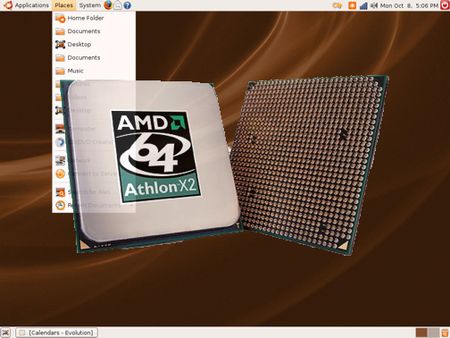Imitation To Innovation: AMD's Best CPUs
Athlon 64 X2: AMD's Dual-Core
In 2005, AMD changed its architecture to offer a dual-core version of the K8, and the Athlon 64 X2 was born. Though made up of two K8 cores, the architecture—using a HyperTransport interface—enabled good performance, unlike the solution used by Intel, with the FSB handling communication between the CPUs in its first dual-core processors. The Athlon 64 X2 exists in different sockets and is still on the market (as of August 2008) as an entry-level solution.
| Code name | Toledo | Brisbane |
| Date released | 2005 | 2006 |
| Architecture | 64-bits | 64-bits |
| Data bus | 64-bits | 64-bits |
| Address bus | 64-bits | 64-bits |
| Maximum memory | 1 TB | 1 TB |
| L1 cache | 64 KB + 64 KB x 2 | 64 KB + 64 KB x 2 |
| L2 cache | 1,024 KB x 2 (CPU frequency) | 512 KB x 2 (CPU frequency) |
| Clock frequency | 2,200-2,400 MHz | 1,900-3,100 MHz |
| Memory controller | DDR-400, 2 channels | DDR2-800, 2 channels |
| FSB | 1,000 MHz (HTT) | 1,000 MHz (HTT) |
| FPU | built-in | built-in |
| SIMD | MMX, Enhanced 3DNow!, SSE, SSE2, SSE3 | MMX, Enhanced 3DNow!, SSE, SSE2, SSE3 |
| Fabrication process | 90 nm | 65 nm |
| Number of transistors | 233.2 million | 153 million |
| Power consumption | 89/110 W (TDP) | 65/89 W (TDP) |
| Voltage | 1.35–1.4 V | 1.25–1.35 V |
| Die surface area | 199 mm² | 126 mm² |
| Connector | Socket 939 | Socket AM2 |
As for the Athlon 64, we’re only showing two versions of the K8, though other versions exist. Obviously there are server versions (Opteron), high-end versions (Athlon 64 FX) and mobile versions (Turion 64 X2), and also entry-level versions in the form of the Sempron X2. One final anecdote: AMD got away with using the same code name for a processor as Intel had used: the Santa Rosa (a dual-core Opteron manufactured on a 90 nm process).
Get Tom's Hardware's best news and in-depth reviews, straight to your inbox.
Current page: Athlon 64 X2: AMD's Dual-Core
Prev Page The K8: AMD Moves To 64 Bits Next Page The Phenom: K10 and Quad-Core-
cpuTweaker Lackluster article...a lot of backround on the chips were left out, fact that make thier acomplishments truely impressive. To THG's credit, their was at least some mention of the impact Alpha had on some of the chip designs, but no where near being complete.Reply
Where the intel article seemed to overshadow intel's little victories, this article seems to gloss over AMD innovation (though i'll admit that i didn't recall the bit about the Intel chip, either the pentium or pentium pro, that gave incorrect values for mathmatical equations)
Both articles really need alot more detail added. As i've actually ranted about the history i'm reffering to in the comments section of the intel article as well as many other's i won't re-hash it. -
neiroatopelcc Despite not being terribly detailed, I still like these recaps. Good articles really, all of them. Now all we need is one on alpha, and on how the mac stuff went before it was called intelReply -
neiroatopelcc Oh and on ati I suppose, seeing we've already had nvidia :9 ... or even matrox, 3dfx and others that have vanished in a combo article...Reply
This is like viasat history - only more specific and technical -
AMD 386 SX @25 MHz was powering my first personal computer. The whole computer costed ~4000$ and it wasn't even top performance.Reply
AMD 486 @120 Mhz was making my friends that bought an early Pentium red with envy.
-
jj463rd I had several systems with the AMD 486 X5 processor at 133 Mhz.I also have 2 K6-2 systems,1 Athlon a Athlon 64 and a Phenom X4 9850 BE system.Actually most of my systems are Intel basedthough.When I first heard that AMD was in pretty big trouble I still wouldn't get a B2 Phenom but when they fixed the bug I decided to help them out by building the Phenom X4 9850BE system which runs very well.Plus I've just ordered some new ATI graphics cards too.Reply
Someone gave me a AMD K5 system.
Thanks for the article. -
Malovane Heh, owned one AMD processor of every line, starting with the 8086 and ending with the Phenom. Wasn't even intentional for the first decade, but I'm glad I did. Liked the article, though it could have gone into a bit more detail and back story.Reply -
Minerva I enjoy these articles as well, as I collect old hardware...Reply
I have quite a few chips from both makers, including the AMD 40MHz 386, and an Intel 386 & 387 33MHz cpu's, which are quite scarce... -
NightLight I too collect old hardware Minerva, in fact, I still have a lot of them still in running order on a mainboard ! Good Review, I just loved to see that windows 3 series again :)Altough a little bit biased...Reply
